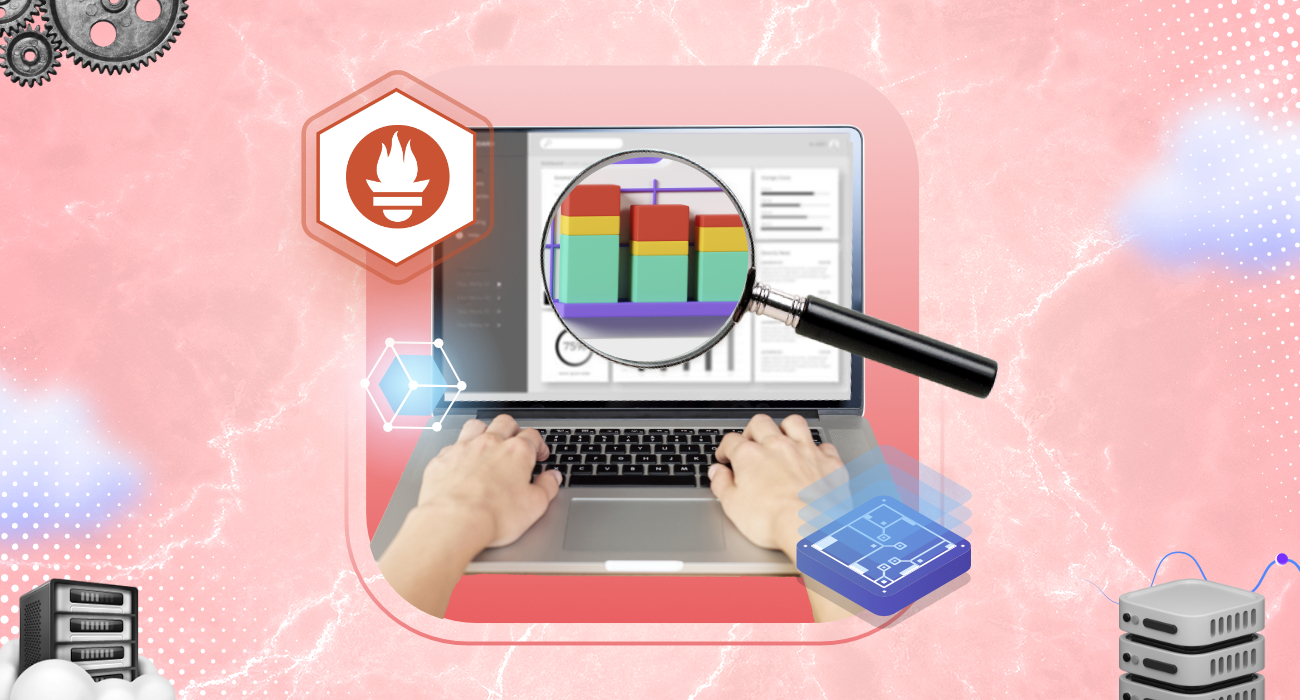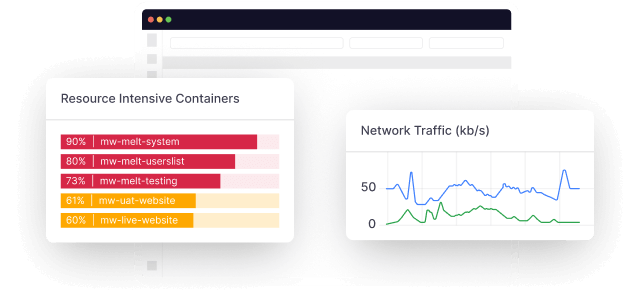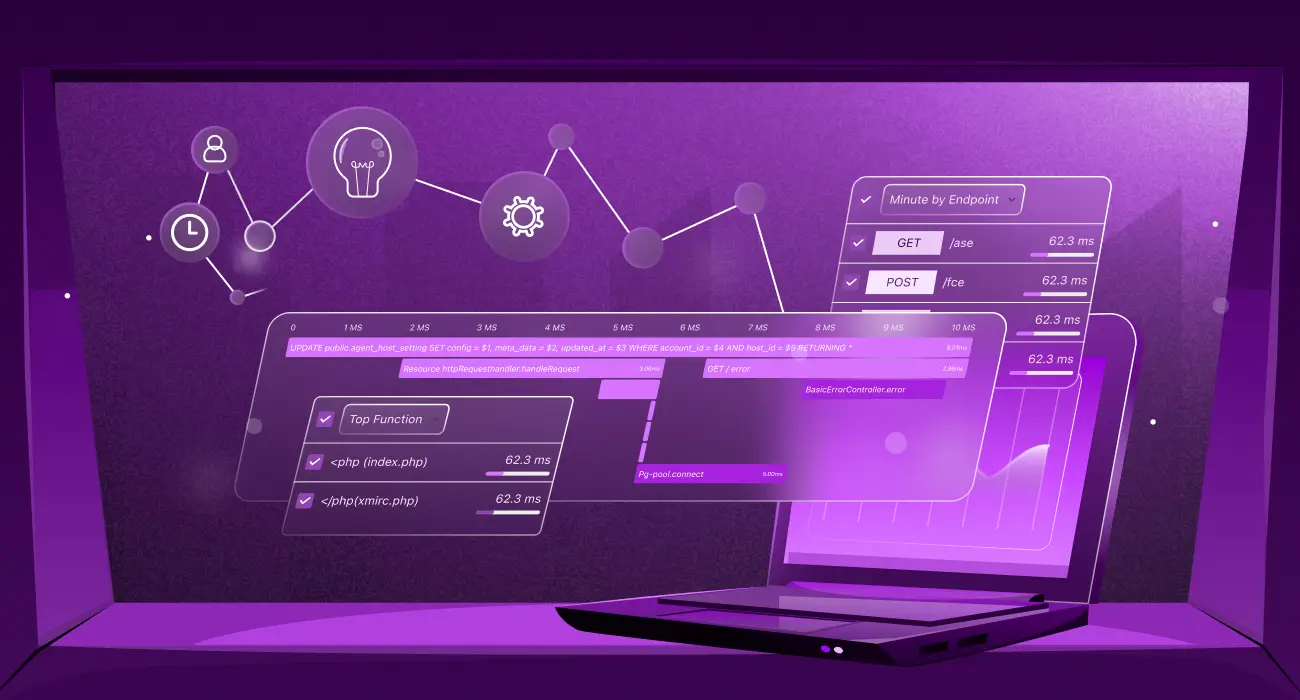Organizations often face the challenge of maintaining high availability and performance across their dynamic and distributed systems. They need robust monitoring solutions that can efficiently collect, query, and analyze metrics to ensure proactive issue detection and resolution.This is where Prometheus excels, offering powerful capabilities to monitor and optimize system performance effectively.
In this article, we will delve into what Prometheus is, its benefits, and how to implement it effectively.
What is Prometheus?
Prometheus is an open-source technology designed to provide robust monitoring and alerting functionality for cloud-native environments, including Kubernetes. It excels in collecting and storing metrics as time-series data, recording information with timestamps, and supporting optional key-value pairs known as labels.
- Time Series Data Collection: Efficiently collects and stores metrics as time series data.
- Powerful Query Language (PromQL): Facilitates complex queries for in-depth analysis.
- Flexible Alerting: Integrates with Alertmanager for customizable alerting and notification.
- Dynamic Target Discovery: Enables the discovery of monitoring targets through both static configurations and dynamic service discovery.
- Advanced Visualization: Offers various graphing and dashboard options to visualize data effectively.
- PromQL: A flexible and powerful query language tailored to harness the multidimensional data model.
Benefits of using Prometheus
Prometheus provides numerous advantages that position it as an ideal choice for monitoring modern applications and infrastructure. Here are some key benefits:
1. Flexibility and vendor neutrality
- Broad compatibility: Prometheus can monitor various systems and services, regardless of vendor. This vendor-neutral approach allows you to integrate Prometheus with diverse technologies in your stack.
- Custom metrics collection: Prometheus supports custom exporters, enabling you to collect metrics from virtually any source, ensuring comprehensive monitoring of your environment.
2. Highly scalable
- Efficient time-series data storage: Prometheus uses a time-series database that efficiently handles large volumes of metrics data. This design makes it suitable for both small deployments and large-scale environments.
- Horizontal scalability: You can horizontally scale Prometheus by sharding the monitoring load across multiple servers, allowing you to manage and monitor extensive infrastructures efficiently.
3. PromQL support
- Powerful query language: Prometheus Query Language (PromQL) is a powerful and flexible language designed for querying and analyzing time-series data. PromQL enables sophisticated queries, aggregations, and calculations, providing deep insights into your system’s performance.
- Real-time analysis: With PromQL, you can perform real-time analysis of metrics, create custom dashboards, and set up complex alerting rules based on your specific needs.
4. Alerting and notification
- Robust alerting capabilities: Prometheus comes with built-in alerting capabilities that allow you to define alert rules based on metric thresholds and conditions. This proactive monitoring helps you detect and address issues before they impact your users.
- Integration with Alertmanager: Prometheus integrates with Alertmanager to manage and route alerts to various notification channels such as email, Slack, PagerDuty, etc. This integration ensures that the right people are notified at the right time.
5. Active community and support
- Vibrant user community: Prometheus is supported by a large and active community of users and developers who contribute to its ongoing development, share best practices, and provide support.
- Extensive documentation: Comprehensive and detailed documentation makes it easy to get started with Prometheus and troubleshoot issues effectively. The community-driven nature of Prometheus ensures that the documentation is continuously updated and improved.
6. Comparison with traditional monitoring tools
- Cost-effectiveness: As an open-source tool, Prometheus is cost-effective compared to traditional monitoring solutions that often involve high licensing costs.
- Flexibility and adaptability: Prometheus’ exporter-based architecture allows for easy adaptation and extension to new environments and technologies, which can be more challenging with traditional tools.
- Dynamic monitoring: Unlike traditional tools that may struggle with dynamic environments like Kubernetes, Prometheus excels with its support for service discovery and dynamic target monitoring.
7. Limitations on data retention
- Data retention: Prometheus is optimized for short-term monitoring data storage. For long-term retention, you may need to consider external solutions, like Middleware, which enhances Prometheus’ data retention capabilities.
Middleware’s Prometheus integration provides features like long-term storage and advanced data management, making it a valuable addition for organizations needing extended data retention periods.
For more information Middleware’s Prometheus integration, click here.
By leveraging these advantages, Prometheus enables technical users, DevOps professionals, and system administrators to monitor, analyze, and optimize their systems effectively, ensuring high availability and performance across their infrastructure.
Core components of Prometheus
The Prometheus architecture primarily focuses on providing robust and efficient time-series data collection, storage, and querying. Here’s an in-depth look into its core components:
1. Prometheus server
The Prometheus server is the heart of the Prometheus ecosystem. Its primary functions include:
- Scraping metrics data: The server periodically scrapes metrics data from various configured targets (e.g., application instances, hardware systems). This data is collected over HTTP in a format defined by Prometheus.
- Storing data efficiently: The collected metrics data is stored as time-series data in a local storage engine. Prometheus uses a custom time-series database to optimize storage efficiency and query performance. The storage engine is designed to handle high write and read throughput.
2. Targets
Targets are the monitored systems or services from which Prometheus collects metrics. The discovery and retrieval process involves:
- Service discovery: Prometheus supports multiple service discovery mechanisms, including static configuration, DNS-based service discovery, Kubernetes, Consul, and more. These mechanisms enable Prometheus to dynamically discover new targets without manual intervention.
- Scraping: Once targets are discovered, Prometheus scrapes them at regular intervals. Each target must expose its metrics at a specific HTTP endpoint (usually /metrics).
3. Exporters
Exporters play a crucial role in converting system-specific metrics into a Prometheus-compatible format. They are intermediary agents that:
- Collect metrics: Exporters collect metrics from various sources, such as system metrics (e.g., CPU, memory usage), application-specific metrics, databases, and more.
- Expose metrics: They then expose these metrics at an HTTP endpoint that Prometheus can scrape. Common exporters include Node Exporter (for hardware and OS metrics), Blackbox Exporter (for probing endpoints), and others.
4. Alertmanager
Alertmanager handles alerts generated by Prometheus. Its primary functions include:
- Managing alerts: It de-duplicates, groups, and categorizes alerts from Prometheus.
- Routing alerts: Alerts are routed to various notification channels such as email, Slack, PagerDuty, etc., based on pre-configured rules.
- Silencing and inhibition: Alertmanager allows for silencing specific alerts and inhibiting certain alerts based on dependencies or redundancies, preventing alert fatigue.
Data model and metrics (Time series)
Prometheus uses a powerful and flexible data model centered around time-series data. Key concepts include:
1. Time series
- Definition: A time series is a sequence of data points collected at successive points in time. Each time series is uniquely identified by a metric name and a set of labels.
- Usage: In Prometheus, time series are used to represent any type of monitored data over time, such as CPU usage, request latency, error rates, etc.
2. Labels and metric names
- Metric names: These are the primary identifiers for time series data. They describe the type of data being recorded, such as http_requests_total, cpu_usage_seconds_total, etc.
- Labels: Labels are key-value pairs associated with a metric name. They provide additional dimensions to the metrics, allowing for detailed querying and aggregation. For instance, an http_requests_total metric might have labels like method=”GET” and handler=”/api/v1/user”, enabling fine-grained analysis.
- Importance:
- Identification: Labels uniquely identify each time series within the context of its metric name.
- Organization: They help organize and categorize metrics, making it easier to filter and group related data.
- Scalability: Labels enable Prometheus to efficiently store and retrieve large volumes of time-series data, even with high cardinality (many unique label combinations).
Implementing Prometheus monitoring
Prometheus works by scraping metrics from configured targets at specified intervals, storing them efficiently in a time-series database, and providing a querying language (PromQL) to analyze and visualize the data. This section will help you implement Prometheus monitoring effectively.
Getting started with Prometheus
To set up and run a basic Prometheus instance, follow these steps:
- Download Prometheus:
- Visit the Prometheus downloads page: Prometheus Downloads.
- Download the latest stable release for your operating system.
- Extract and configure Prometheus:
- Extract the downloaded Prometheus archive to a directory of your choice.
- Navigate to the prometheus-<version>.<platform> directory.
Edit the prometheus.yml configuration file to define your scrape targets. Here’s a basic example:
yaml
global:
scrape_interval: 15s
scrape_configs:
- job_name: 'prometheus'
static_configs:
- targets: ['localhost:9090'] # Replace with your Prometheus server's address3. Start Prometheus:
- Open a terminal window and navigate to the directory where you extracted Prometheus.
Start Prometheus using the following command:
Bash
./prometheus --config.file=prometheus.yml4. Access Prometheus UI:
- Open a web browser and go to http://localhost:9090 (replace localhost with your server’s address if different).
- You should see the Prometheus expression browser.
Writing PromQL queries
PromQL is Prometheus’ powerful query language that allows you to retrieve and manipulate time-series data. Here’s how to write basic and advanced PromQL queries:
Basic queries
Retrieve data points:
//promql
up
This query retrieves the up metric, which indicates whether the Prometheus server is up (1) or down (0).
Retrieve time series range:
//Promql
rate(http_requests_total[5m])This query calculates the per-second rate of HTTP requests over the last 5 minutes.
Advanced queries
Filtering with labels:
/promql
http_requests_total{job="myapp", status="200"}Retrieves the total number of HTTP requests with a status code 200 from the myapp job.
Aggregation and calculation:
//promql
sum(rate(http_requests_total{job="myapp"}[1h])) by (endpoint)Calculates the per-second rate of HTTP requests aggregated by endpoint over the last hour.
Alerting and notification configuration
Setting up alerts and notifications in Prometheus involves defining alert rules and configuring Alertmanager:
Creating alert rules
- Edit prometheus.yml
Add the following section to prometheus.yml to define alerting rules:
//yaml
rule_files:
- alert.rules.yml2. Create alert.rules.yml
Create a file named alert.rules.yml and define your alerting rules.
For example:
Yaml
groups:
- name: example
rules:
- alert: HighRequestRate
expr: rate(http_requests_total{job="myapp"}[5m]) > 100
for: 1m
labels:
severity: critical
annotations:
summary: High request rate detected
description: '{{ $value }} requests per second for {{ $labels.instance }}'Integrating Alertmanager
- Configure Alertmanager
Edit alertmanager.yml to define alerting and notification configurations. Here’s a basic example:
yaml
global:
slack_api_url: 'https://hooks.slack.com/services/T00000000/B00000000/XXXXXXXXXXXXXXXXXXXXXXXX'
route:
group_by: [Alertname, severity]
receiver: slack_notifications
receivers:
- name: 'slack_notifications'
slack_configs:
- channel: '#alerts'
send_resolved: true2. Start Alertmanager
Start Alertmanager using the following command:
bash
./alertmanager --config.file=alertmanager.yml3. Verify alerts
- To test your setup, trigger an alert condition (e.g., by exceeding the high request rate) and verify that alerts are sent to the configured notification channel.
By following these steps, you can effectively set up and utilize Prometheus for monitoring, querying, alerting, and notification management in your environment. Adjust the configurations and examples to fit your specific monitoring requirements and infrastructure setup.
Advanced Prometheus usage
Prometheus offers advanced features and capabilities beyond basic monitoring and alerting.This section discusses advanced functionalities and best practices for optimizing Prometheus usage.
1. Remote write
Purpose: Prometheus offers a remote write API that allows you to push metrics data to Prometheus from any location, making it suitable for distributed monitoring setups.
Configuration: To enable remote write, modify your prometheus.yml configuration file:
Yaml
remote_write:
- url: http://remote-prometheus:9090/writeUse Cases: Useful for integrating metrics from multiple Prometheus servers across different locations or for aggregating metrics from various sources into a centralized Prometheus instance.
2. Read API
- Purpose: Prometheus also provides a read API that allows external applications to query Prometheus data programmatically.
- Endpoints: The read API endpoints include /api/v1/query, /api/v1/query_range, and /api/v1/series, among others.
- Integration: External applications can use these endpoints to retrieve Prometheus metrics data for custom analysis, reporting, or integration with other tools.
Integration with other tools
Grafana
- Purpose: Grafana is a popular visualization tool that complements Prometheus by providing rich visualizations and dashboards.
- Setup:
- Install Grafana: Download and install Grafana from their official website.
- Configure Grafana Data Source: Add Prometheus as a data source in Grafana by specifying the URL of your Prometheus server.
- Create Dashboards: Build custom dashboards using Grafana’s intuitive interface and query editor, utilizing PromQL to fetch data from Prometheus.
Example query in Grafana
Create a dashboard panel in Grafana:
//promql
sum(rate(http_requests_total{job="myapp"}[5m])) by (instance)- This query calculates the per-second rate of HTTP requests grouped by instance over the last 5 minutes.
Alerting in Grafana
- Grafana can also be configured to use Prometheus’ alerting capabilities by integrating with Alertmanager.
- Alerts created in Prometheus can be displayed and managed in Grafana dashboards, enhancing visibility and management.
Best practices and tips
Here are some recommended practices to consider when working with Prometheus:
Efficient data storage and retention strategies
- Retention Period: Configure appropriate retention periods in Prometheus based on your monitoring needs and compliance requirements.
- Storage Optimization: Implement efficient storage strategies, including utilizing remote storage solutions or middleware for long-term data retention.
- Data Sharding: For large-scale deployments, consider sharding Prometheus servers to distribute the monitoring load and improve performance.
Security considerations
- Secure Communication: Ensure all communications between Prometheus, Alertmanager, and other components are encrypted using HTTPS.
- Access Control: Implement role-based access control (RBAC) to restrict access to Prometheus APIs and dashboards based on user roles and responsibilities.
- Authentication: Use authentication mechanisms such as OAuth or LDAP to secure access to Prometheus and Grafana.
Performance optimization
- Query Optimization: Write efficient PromQL queries to minimize resource consumption and improve query response times.
- Monitoring and Tuning: Monitor Prometheus server metrics using its own instrumentation and Grafana dashboards to identify performance bottlenecks and optimize server configuration.
Backup and disaster recovery
- Regular Backups: Implement regular backups of Prometheus data and configuration to ensure quick recovery in case of data loss or server failure.
- Disaster Recovery Plan: Develop and test a disaster recovery plan to restore it’s infrastructure in case of major incidents or outages.
Conclusion
We have explored Prometheus, an advanced monitoring and alerting toolkit tailored for cloud-native environments. We’ve seen its robust feature set, including remote write and read APIs for distributed monitoring and integration with external applications.
Next steps include implementing remote APIs, optimizing Prometheus configuration, and exploring additional integrations to maximize monitoring effectiveness. By doing so, you can ensure reliable performance monitoring and operational excellence across your infrastructure.
Explore Middleware to enhance your monitoring setup and optimize your system’s performance.




